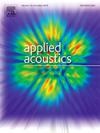Defect induced non-axisymmetric transmitted wave model based on the periodic energy distribution changing analysis for high attenuation circular tube defect detection
IF 3.4
2区 物理与天体物理
Q1 ACOUSTICS
引用次数: 0
Abstract
The pulse-echo signal receiving model can effectively determine a defect’s axial position through the time flight of the defect echo. However, some materials or buried structures may significantly attenuate the ultrasonic-guided wave, making the defect echo challenging to observe. Compared with the pulse-echo mode, the guided wave in the pitch-catch signal-receiving model only needs to propagate a one-way distance. Its transmitted wave is more straightforward to observe. However, the pitch-catch model is difficult to judge if a defect exists in the pitch-catch model and identify the position of a defect through the transmitted wave. The paper presents a defect-induced non-axisymmetric transmitted wave model. It can balance the advantages and disadvantages of the two signal-receiving models. First, the periodic energy distribution altering rule of the non-axisymmetric torsional guided wave within a circular tube was theoretically analyzed. Second, the numerical and experimental results verified the theoretical analysis. Third, the defect-induced non-axisymmetric transmitted wave model was proposed based on its periodic energy distribution changing rule analysis to evaluate whether a defect exists, while the traditional pitch-catch models cannot achieve it. The axial and circumferential positions of a circumferential crack within a circular tube encased in concrete can be estimated using the proposed model, which is challenging to realize by the traditional pulse-echo models.
基于周期能量分布变化分析的缺陷诱导非轴对称透射波模型在高衰减圆管缺陷检测中的应用
脉冲回波信号接收模型可以通过缺陷回波的时间飞行有效地确定缺陷的轴向位置。然而,某些材料或埋地结构可能会使超声引导波明显衰减,使缺陷回波难以观察。与脉冲回波模式相比,节距捕捉信号接收模式下的导波只需要传播一段单向距离。它的透射波更容易观察。然而,pitch-catch模型难以判断pitch-catch模型中是否存在缺陷,也难以通过透射波识别缺陷的位置。提出了一种缺陷诱导非轴对称透射波模型。它可以平衡两种信号接收模式的优缺点。首先,从理论上分析了非轴对称扭转导波在圆管内的周期性能量分布变化规律;数值和实验结果验证了理论分析的正确性。第三,提出了缺陷诱导非轴对称透射波模型,通过分析其周期性能量分布变化规律来评估缺陷是否存在,而传统的俯仰捕捉模型无法实现缺陷诱导非轴对称透射波模型。利用该模型可以估计出混凝土包裹圆形管内圆周裂纹的轴向和周向位置,这是传统脉冲回波模型难以实现的。
本文章由计算机程序翻译,如有差异,请以英文原文为准。
求助全文
约1分钟内获得全文
求助全文
来源期刊

Applied Acoustics
物理-声学
CiteScore
7.40
自引率
11.80%
发文量
618
审稿时长
7.5 months
期刊介绍:
Since its launch in 1968, Applied Acoustics has been publishing high quality research papers providing state-of-the-art coverage of research findings for engineers and scientists involved in applications of acoustics in the widest sense.
Applied Acoustics looks not only at recent developments in the understanding of acoustics but also at ways of exploiting that understanding. The Journal aims to encourage the exchange of practical experience through publication and in so doing creates a fund of technological information that can be used for solving related problems. The presentation of information in graphical or tabular form is especially encouraged. If a report of a mathematical development is a necessary part of a paper it is important to ensure that it is there only as an integral part of a practical solution to a problem and is supported by data. Applied Acoustics encourages the exchange of practical experience in the following ways: • Complete Papers • Short Technical Notes • Review Articles; and thereby provides a wealth of technological information that can be used to solve related problems.
Manuscripts that address all fields of applications of acoustics ranging from medicine and NDT to the environment and buildings are welcome.
 求助内容:
求助内容: 应助结果提醒方式:
应助结果提醒方式:


